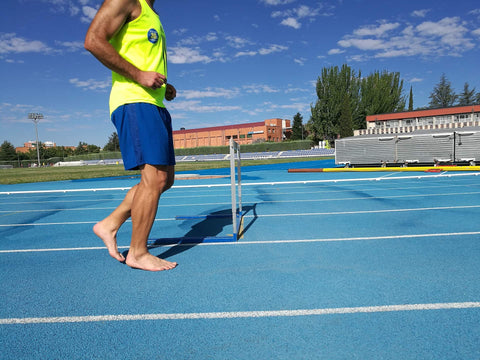As a runner what is the one thing we all love to brag about to other runners? Our PR’s of course! It is always exciting telling other running enthusiasts your latest PR and how much you have improved, but how do we improve? Could be a matter of more training runs, maybe eating properly beforehand, or just simply getting faster? Sure our running gear like shoes can play a small part and it’s great to have some reflective clothing for safety but what about our bodies health by running safely?
One thing often overlooked by runners is their form. Experts say there are 4 key components to good running form and they are posture, alignment, pelvis stability, and hip strength. Running with proper form can make a huge difference in your abilities and help you avoid injury, so let’s take a look at a few tips to get you in running form!
Slow Cadence
Your running speed is determined by your stride length multiplied by stride frequency. Many runners first attempt is to increase their stride length, which in turn reduces stride frequency. Under optimal conditions this should be around 180 foot strikes per minute. An easy way to count stride frequency is to count your steps for 15 seconds and multiply by 4.
The more time your feet spend on the ground, the more energy is required to propel it forward. Focus on increasing your cadence, and in turn, your efficiency. By adjusting our stride length we change a lot about our form. Check out this breakdown video on Chris Solinsky running a 10K and get a good understanding of how adjusting one thing in your form changes many other components of your form.
Chris Solinsky Stride Analysis from Somax Performance Institute on Vimeo.
Heel Striking
For many runners a slow cadence often goes hand-in-hand with heel striking. This occurs when your hips are behind your feet. You cannot push off your foot when it is in front of your hips. Your hips must come over your feet in order to propel you forward.
A great way to practice to avoid heel striking is by running barefoot or with minimalist shoes. By running with little to nothing on your feet you are much more likely to run as you are intended too. This happens because your natural instincts will try and keep you from slamming your heel down as to avoid injury and with no padding there you know it will hurt if you do.

Try running barefoot on some turf or grass for 30 seconds at a time and notice how you naturally change your form to adjust. Keep that in mind for the next time you tie your shoes on for a run.
Lack of Mobility
When it comes to fast running and staying injury free mobility trumps all. If you lack complete range of motion anywhere in your lower body, you are going to be more susceptible to injury. By properly stretching we can loosen up those tight areas and lengthen our muscles which in turn will help prevent injury and improve performance.
A great modern method of stretching called Active Isolated Stretching was made popular by stretching guru Phil Wharton. Phil, who has worked with some of the top runners in the world over the last 15 years, explains the science of flexibility and demonstrates a few key Active-Isolated stretches in this video.
Stiff Upper Body
One of the most challenging things to do while running is to keep relaxed and run fast at the same time. Often times we stiffen up as we run. Here are a few ways to loosen up your upper body while you’re out:
- Keep your arms at 90° and do not release that angle in your backswing or you will only be wasting energy
- At each mile marker raise your shoulders to your ears then drop them back down into a relaxed position
- Try the hands-on-head drill by interlocking your hands and placing them on the top of your head. Focus on keeping your core solid and straight while keeping the hips and shoulders level and relaxed. Start jogging. This drill will help you to eliminate any left to right movement through the hips and help eliminate a criss-crossing, side-to-side arm carriage.
Running Right
While running may seem like a thing we as a species do fairly naturally it is so important to be doing it correctly. By running with proper form we can reduce our risk of injury and increase our performance. As a runner I can’t think of anything better than those two key points. Who doesn’t want to reduce risk of injury and increase performance? I know I do.
So keep your form in mind next time you go for a run and remember to wear your reflective running gear! Be safe, seen, and stylish day or night! Cheers!


